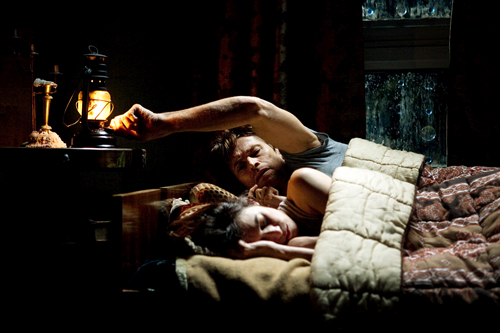
Lars Von Trier’s controversial 2009 film Antichrist was written while the director was under the influence of what he called a “deep depression,” and it shows.
The film has been called misogynistic by various reviewers, “a load of balls” (Willamette Week) and “dumb” (The New York Times). It has also been hailed as a challenging, philosophically insightful piece of cinema, among the best of the Danish provocateur’s offerings.
I offer these contrasting views because, three days later, I’m still reeling from its dizzying pirouettes from art-house shock to pretentious schlock.
The film is Von Trier’s attempt at the horror genre—an attempt heavily informed by the last decade’s unfortunate spate of torture-driven horror flicks. Consequently, there are several scenes that I may never forget, try as I might. (Close-up auto-clitoraldectomy with a rusty pair of scissors, anyone?)
Fortunately, what Antichrist lacks in subtlety, it sometimes makes up for in sheer cinematic technique.
The film begins, for example, with a slow motion, black-and-white sequence of Willem Dafoe and Charlotte Gainsbourg making love all over the place, with a flash of hardcore presumably thrown in just to push the proverbial envelope.
An adorable child, teddy bear in tow, leaves his bed and toddles over to see what mommy and daddy are doing. And then, perhaps drawn by the gently falling snow outside, he climbs up to an open window. His prompt fall from it to the snowy pavement far below is made more suspenseful through the alternation of still shots and slow motion. Set to Handel’s sentimental aria “Rinaldo Lascia Ch’io Pianga,” the scene feels mawkishly ironic.
It’s an eye-rolling, over-the-top introduction to a movie that delivers much more of the same. Von Trier starts with a good idea then quickly exaggerates it into caricature. In fact, the whole movie is a caricature—of itself.
This isn’t to suggest that there’s nothing worth seeing here. Much of the scenery is striking in its skeletal, high-contrast depiction of the natural world. Dafoe and Gainsbourg, whose characters remain nameless (because Antichrist is an allegory, I suppose), viciously making a dry and brutal kind of love against the knotty roots of a large tree, embody the apex of this aesthetic—Gainsbourg especially, as she begins the film as a regular skinny chick and quickly becomes downright emaciated.
Nature is a dominant theme, and Gainsbourg’s character has a terrifying fear of a place they call Eden. But Eden is defined less by verdant fields and birdsong and more by decay, screeching crows and a campy, animatronic, self-eviscerating fox with a computer-generated face that growls, “Chaos Reigns!” Dafoe approaches a deer that turns to run, revealing a stillborn fawn still hanging out of it. A dead baby bird covered in ants falls from its nest. What does it all mean?
It means that nature is pretty scary, or, as Gainsbourg’s character put it, “Nature is Satan’s church.” And Satan means witches. We learn that “her” (as she’s credited) history with this place was that she came here to finish her college thesis titled “Gynocide.”
Dafoe learns the hard way that though his wife set out to tell the stories of women accused of witchcraft in the 16th century, what she discovered was women’s propensity toward evil—including her own.
The noir cinematography, the grotesquery of the natural world and the human body, and the theme of the horrific supernaturalism residing in the commonplace call to mind the more bizarre work of Francisco De Goya. If only Antichrist was as compelling as the work of that Spanish romantic artist. The film promises a lot that it fails to deliver.
Antichrist is artsy without being engaging. It’s serious and philosophical but often campy and silly. And most egregiously, it’s a horror film that isn’t scary. Sure, there are plenty of spooky scenes and things that go thunk in the night. But the only scenes that make any impression are those of graphic violence, which is cheap and easy.
The problem is, I didn’t care what happened to Dafoe or Gainsbourg. I want that smug self-assurance wiped off his therapist face. I want her to quit whining. And I don‘t care that the child is dead because the circumstances are so ridiculous I can’t buy it.
Von Trier tries hard with his technical savvy and arsenal of visual effects, but by failing to evoke empathy he fails on the most basic level of storytelling.
Von Trier claims a lot of research in the credits. He credits a misogyny researcher, a mythology and evil researcher and an anxiety researcher, among others. He could have just hired a real therapist to help him through his misanthropic depression without inflicting it upon his undeserving audience.
British tabloid movie reviewer Baz Bamigboye angrily asked Von Trier why he made the film. Frankly, I don’t believe the public has any right to demand explanations from artists, providing they haven’t committed a crime. The only crimes committed by the making of Antichrist are against good taste.
Lars Von Trier’s Antichrist (2009)
Friday, April 6, at 9:30 p.m.
Saturday, April 7, at 9:30 p.m.
Sunday, April 8, at 3 p.m.
Free for PSU students and faculty with ID;
$2 for all other students and seniors;
$3 general admission.
